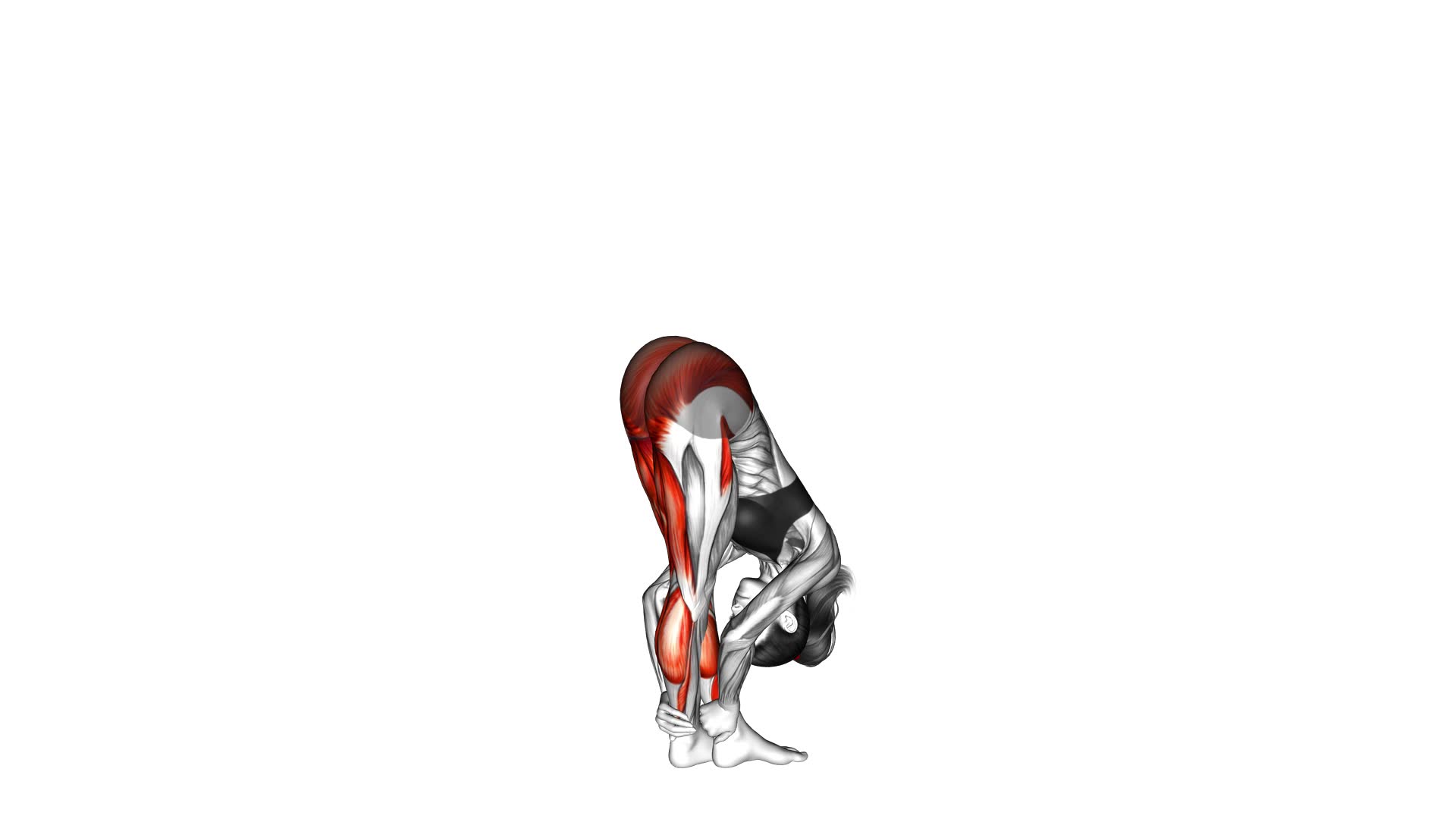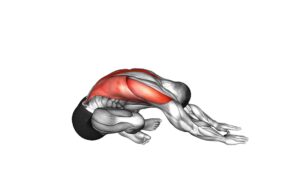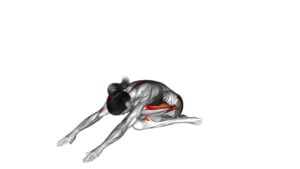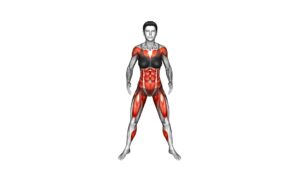Standing Reach Down Hamsting Crossed Legs Stretch (female) – Video Exercise Guide & Tips

Are you looking to improve your flexibility and strengthen your hamstrings? Look no further!
Watch This Exercise Video
In this video exercise guide, we'll show you how to perform the standing reach down hamstring crossed legs stretch. This stretch is perfect for targeting your hamstrings and increasing your lower body flexibility.
Whether you're a beginner or an advanced fitness enthusiast, this stretch can be modified to suit your fitness level.
So let's get started and incorporate this stretch into your workout routine for maximum benefits!
Key Takeaways
- The Standing Reach Down Hamstring Crossed Legs Stretch improves flexibility in hamstrings and hips.
- It increases range of motion in the lower body and enhances mobility and flexibility for athletes and active individuals.
- The stretch helps prevent strains and pulls during physical activity and strengthens muscles to withstand stress and prevent injuries.
- Proper form and technique, as well as modifications and variations for different fitness levels, are crucial for performing the stretch safely and effectively.
Benefits of the Standing Reach Down Hamstring Crossed Legs Stretch
You can experience numerous benefits by incorporating the standing reach down hamstring crossed legs stretch into your fitness routine. This stretch is highly effective in improving flexibility and preventing injuries. By regularly performing this stretch, you can increase the range of motion in your hamstrings and hips, allowing for greater mobility and flexibility in your lower body. This increased flexibility can be especially beneficial for athletes and individuals who engage in activities that require a wide range of leg movements, such as running, dancing, and martial arts.
In addition to improved flexibility, the standing reach down hamstring crossed legs stretch also helps to prevent injuries. By stretching the hamstrings and hip flexors, you can reduce the risk of strains and pulls during physical activity. This stretch also helps to lengthen and strengthen the muscles, which can enhance their ability to withstand stress and prevent injuries.
To maximize the benefits of this stretch, it's important to maintain proper form and technique. By following the correct form, you can ensure that you're targeting the intended muscles and avoiding unnecessary strain. In the next section, we'll discuss the proper form and technique for the standing reach down hamstring crossed legs stretch, so you can perform it safely and effectively.
Proper Form and Technique for the Stretch
To perform the standing reach down hamstring crossed legs stretch with proper form and technique, focus on maintaining a straight back and engaging your core muscles. This will help ensure that you're targeting the correct muscles and maximizing the benefits of the stretch. Here are three key points to keep in mind:
- Importance of flexibility in hamstring muscles: The hamstring muscles play a crucial role in various lower body movements, such as walking, running, and jumping. Having flexible hamstrings allows for greater range of motion and can improve overall athletic performance.
- The role of stretching in preventing hamstring injuries: Regular stretching helps to increase the flexibility and elasticity of the hamstring muscles, reducing the risk of strains or tears. By incorporating the standing reach down hamstring crossed legs stretch into your routine, you can help prevent hamstring injuries and promote healthy muscle function.
- Proper body alignment: When performing this stretch, it's essential to maintain a straight back and avoid rounding the shoulders or hunching forward. This position ensures that the stretch targets the hamstrings effectively and minimizes the risk of strain on the lower back.
By following these guidelines, you can perform the standing reach down hamstring crossed legs stretch correctly and reap the benefits of improved hamstring flexibility and injury prevention.
Now, let's explore modifications and variations for different fitness levels.
Modifications and Variations for Different Fitness Levels
For different fitness levels, it's important to consider modifications and variations for the standing reach down hamstring crossed legs stretch. This will allow individuals to safely and effectively engage in the exercise based on their abilities and goals.
To progress the standing reach down hamstring crossed legs stretch, you can increase the duration of the stretch or the number of repetitions. This will help to further improve flexibility and range of motion in the hamstrings. Additionally, you can incorporate weights or resistance bands to add an extra challenge and increase the intensity of the stretch.
For those who are beginners or have limited flexibility, modifications can be made to make the exercise more accessible. One modification is to use a stability ball or a foam roller for support. This will provide additional balance and stability while performing the stretch. Another modification is to perform the stretch while seated on a chair or bench. This will reduce the amount of weight and pressure on the hamstrings, making it easier to perform the stretch.
Remember to listen to your body and only progress to more challenging variations when you feel comfortable and ready. Always consult with a fitness professional before making any modifications to ensure the exercise is safe and suitable for your fitness level.
Common Mistakes to Avoid During the Stretch
During the standing reach down hamstring crossed legs stretch, it's important to be aware of common mistakes that should be avoided to ensure proper form and prevent injury. Here are some common mistakes to watch out for:
- Rounding the back: One of the most common mistakes is rounding the back during the stretch. This not only reduces the effectiveness of the stretch but also puts unnecessary strain on the spine. To maintain proper form, focus on keeping your back straight and your chest lifted throughout the stretch.
- Locking the knees: Another mistake to avoid is locking your knees during the stretch. This can lead to hyperextension and increase the risk of injury. Instead, keep a slight bend in your knees to engage the muscles and protect the joints.
- Holding the breath: Many people tend to hold their breath when performing stretches. However, it's important to remember to breathe deeply and rhythmically throughout the exercise. This helps to oxygenate the muscles and promote relaxation.
Tips for Incorporating the Stretch Into Your Workout Routine
To incorporate the standing reach down hamstring crossed legs stretch into your workout routine, follow these tips for optimal results.
First, it's important to warm up your muscles before attempting any stretching exercises. This can be done through light cardio activities such as jogging or jumping jacks.
Once your muscles are warmed up, find a comfortable space with enough room to perform the stretch. Start by standing with your feet hip-width apart and crossed at the ankles.
Slowly hinge forward at the hips, keeping your back straight and reaching towards the ground. Remember to engage your core muscles and breathe deeply throughout the stretch.
Hold the position for 20-30 seconds and then slowly return to the starting position. Repeat the stretch on the opposite side.
It's recommended to incorporate this stretch into your workout routine 2-3 times per week for maximum benefits. Remember to listen to your body and never force a stretch beyond your comfort level.
Frequently Asked Questions
Is the Standing Reach Down Hamstring Crossed Legs Stretch Suitable for Pregnant Women?
During pregnancy, it's important to modify exercises to ensure your safety. The standing reach down hamstring crossed legs stretch may not be suitable for pregnant women due to the potential strain it can place on your abdominal muscles and pelvic area.
It's always best to consult with your healthcare provider for alternative stretches that are safe and effective during pregnancy. Prioritizing your well-being and the well-being of your baby is key.
Can I Perform the Stretch if I Have a Knee Injury?
If you have an injured knee, it isn't recommended to perform the standing reach down hamstring crossed legs stretch. This exercise puts strain on the knee joint and may worsen your injury.
It's important to prioritize your recovery and avoid any movements that could aggravate the knee. Instead, consider alternative stretches that are safe for knee injuries, such as seated hamstring stretches or quad stretches.
Always consult with a healthcare professional for specific modifications and guidance.
How Often Should I Do the Standing Reach Down Hamstring Crossed Legs Stretch to See Results?
To see results from the standing reach down hamstring crossed legs stretch, it's important to find the optimal frequency that works for you.
Start by doing the stretch at least 2-3 times a week and gradually increase the frequency as your flexibility improves.
Beginners can modify the stretch by keeping the legs slightly apart or bending the knees slightly.
Remember to listen to your body and not push beyond your comfort level to prevent injury.
Can I Perform the Stretch if I Have Lower Back Pain?
If you're experiencing lower back pain, it's important to listen to your body and avoid any exercises that may aggravate it.
Instead of the Standing Reach Down Hamstring Crossed Legs Stretch, you can try yoga modifications or alternative stretches that are gentle on your lower back.
Consult with a qualified instructor or healthcare professional for specific recommendations tailored to your condition.
Safety and proper form are key when dealing with any type of pain or injury.
What Are the Benefits of Incorporating the Standing Reach Down Hamstring Crossed Legs Stretch Into a Yoga Practice?
Incorporating the standing reach down hamstring crossed legs stretch into your yoga practice can provide various benefits.
This stretch helps increase flexibility, allowing you to move more freely and deeply into other poses.
It also improves posture by stretching the hamstrings, which can alleviate tension in the lower back and promote a more upright position.
Additionally, this stretch helps reduce muscle tension, allowing you to relax and release any tightness in the hamstrings.
Conclusion
Incorporating the standing reach down hamstring crossed legs stretch into your workout routine can provide numerous benefits.
This stretch helps to improve flexibility and mobility in the hamstrings, reducing the risk of injury and enhancing overall athletic performance.
By following proper form and technique, and making modifications based on your fitness level, you can effectively stretch your hamstrings.
Avoiding common mistakes and consistently incorporating this stretch into your routine will help you achieve better results.

Author
Years ago, the spark of my life’s passion ignited in my mind the moment I stepped into the local gym for the first time. The inaugural bead of perspiration, the initial endeavor, the very first surge of endorphins, and a sense of pride that washed over me post-workout marked the beginning of my deep-seated interest in strength sports, fitness, and sports nutrition. This very curiosity blossomed rapidly into a profound fascination, propelling me to earn a Master’s degree in Physical Education from the Academy of Physical Education in Krakow, followed by a Sports Manager diploma from the Jagiellonian University. My journey of growth led me to gain more specialized qualifications, such as being a certified personal trainer with a focus on sports dietetics, a lifeguard, and an instructor for wellness and corrective gymnastics. Theoretical knowledge paired seamlessly with practical experience, reinforcing my belief that the transformation of individuals under my guidance was also a reflection of my personal growth. This belief holds true even today. Each day, I strive to push the boundaries and explore new realms. These realms gently elevate me to greater heights. The unique combination of passion for my field and the continuous quest for growth fuels my drive to break new ground.







